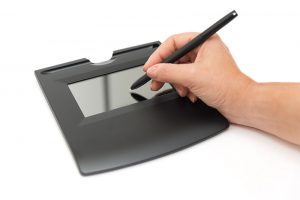What Is Signature Verification?

Signature verification is the process of comparing a presented signature to a reference signature to assess the validity of the presented signature. Financial institutions, election monitors, and other entities use signature verification techniques to look for forgeries.
Traditionally, humans manually performed this process, and they continue to do so for many applications. However, there is also signature verification software that can automate the process. Most analysts agree that the best approach is a hybrid of automated software with human oversight.
Elements Assessed in the Signature Verification Process
Whether a human or digital tool is analyzing a signature, they look at the following elements:
- How the name is spelled.
- The use of print or cursive letters.
- Individual preferences in font style, such as how loops are rendered, dots are drawn, or letters are crossed.
- Direction and angle of the signature’s slant.
- Size of the signature.
- Proportion of different signature elements in relation to each other.
- How the signature starts and ends, such as sudden ends, long tails, or loops.
- The strokes connecting different elements of the signature.
- Spacing between the first and last name and between the letters in the signature.
- The positioning of pen lifts.
- Speed of the writing.
Acceptable Variations in Signatures
People don’t always sign their names in the exact same way. When someone is manually checking signatures, they must keep in mind that some level of variation is inevitable. In particular, they should consider the following acceptable variations:
- Shaky signatures — If the other elements such as the size and the position of pen lifts appear to be consistent, shakiness can often be a sign of health issues, aging, or just too much coffee on a bad day.
- Name variations — Ideally, customers should sign their checks with the same legal name noted on the account, but common variations such as nicknames (for example, Don for Donald or Toby for Tobias), initials, or using their middle name as their first name, are not necessarily signs of forgery. In fact, a forger is less likely to make these types of mistakes than an authentic signer.
- Slight changes in style — People make slight changes to their signature over time. In these situations, it’s especially important to pay attention to the fluidity of the signature.
- Aberrations from electronic signature tools — If someone signs their name with an electronic pen onto a screen, the signature may appear fuzzy or larger than usual. However, it should still have similar proportions and pen lift spots.
- Odd bumps — This can indicate that the signature was done on an uneven or bumpy surface.
When in doubt, verifiers should get a second opinion. If they still can’t come to a conclusion, they should reach out to the person whose signature they’re assessing.
What if a Bank Can’t Verify a Signature?
If a bank cannot verify a signature, they should stop the transaction. They should reach out to the customer to verify the legitimacy of the transaction. If the customer’s signature has changed drastically, they should update the reference signature on file.
What Is Signature Verification Software?
Signature verification software refers to applications that automatically compare signatures to look for forgeries. These tools help banks and other institutions to authenticate signatures without paying people to manually review signatures. Like manual reviewers, signature verification software compares a presented signature with a reference signature.
After comparing the two signatures, the software issues a confidence score. A high score indicates authenticity, while a low score indicates a heightened risk of fraud. Then, the software usually asks your team to step in and make the final decision. That’s generally when you reach out to the customer for verification.
Benefits of Signature Verification Software
When compared to manual verification methods, software offers the following advantages:
- Reduce risk of error.
- Faster verification process.
- Lower labor costs.
- Ability to scan more signatures, with fewer resources.
Additionally, thanks to modern technology, you don’t need a lot of hardware or big on-site servers to bring powerful signature verification tools to your bank. Now, there are lightweight solutions that can hold huge databases and check multiple signatures against a single ID. These same tools can also help you extract signatures from documents and store them for verification purposes.
Manual Vs. Software Signature Verification
Manual signature verification uses humans to compare signatures. Software verification tools also compare presented signatures with reference signatures. They use image processing, pattern recognition and machining learning to look for minute variations between the two signatures. This speeds up the process and reduces the risk of errors.
Usually, when banks rely on humans to complete signature verification processes, they only review checks over a certain threshold. In contrast, when you use software to perform this function, you can review all of the checks presented at your bank. Then, when the software spots a potential issue, you can have a human review the situation.
Improve Your Signature Verification Processes
At SQN Banking Systems, we are a leader in the signature verification market. Our signature verification tools can help speed up review times, improve accuracy, and most importantly, reduce fraud risks. To learn more, contact us today.
We also offer other fraud prevention and detection strategies for our banking clients. We customize our offerings to meet the unique needs of your financial institution, and we look forward to helping your financial institution.
